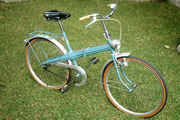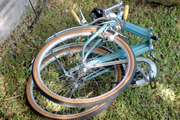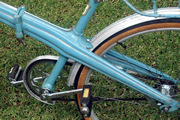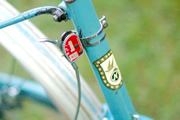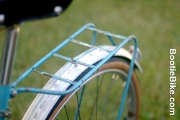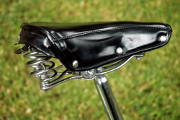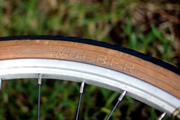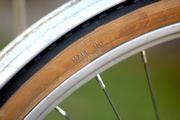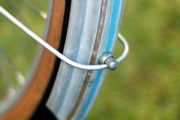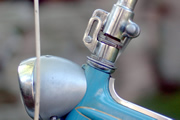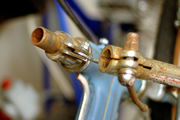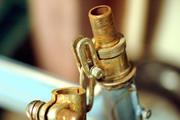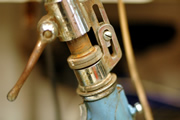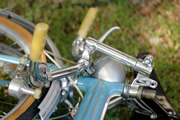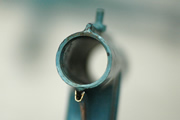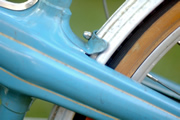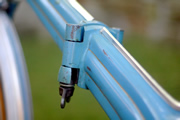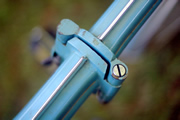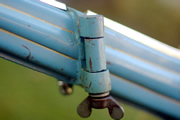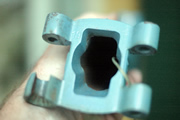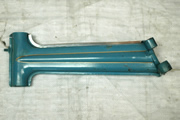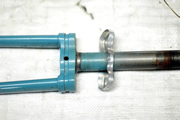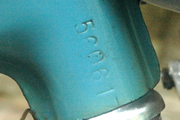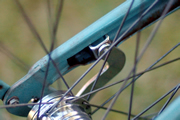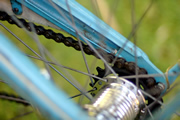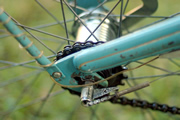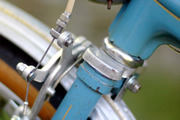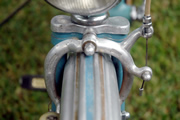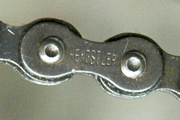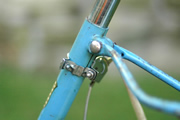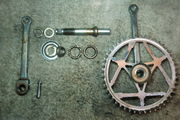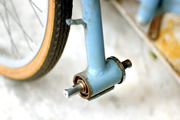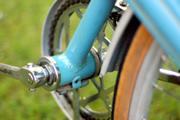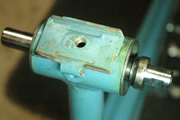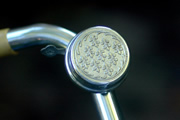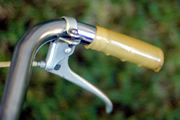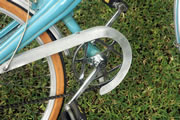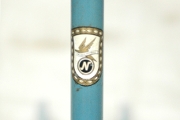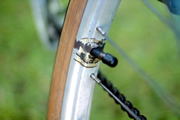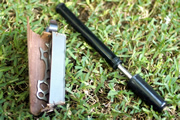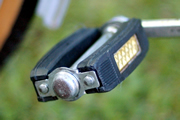1964 Neckermann 26” Faltfahrrad
German glamour
It's time to visit Germany, home of the splendid Neckermann folder. It may seem unlikely, but this most glamorous of bicycles was sold alongside pots, pans and other household goods, as well as conventional bicycles, 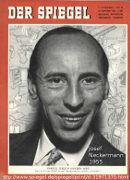 deep within the pages of a mail order
deep within the pages of a mail order 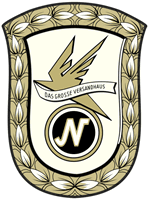 catalogue.
catalogue.
That catalogue was for the Neckermann mail order house, which was established in 1938 (in questionable circumstances) by one Josef Neckermann, who went on to become an equestrian champion at four Olympic Games. His company, promoted as 'Das Grosse Versandehaus' ('the big mail order house'), traded until 2012.
The bike bears the name of the mail order house, but it was made by Geier-Werke in Lengerich, near the northern city of Osnabrück. Initially I couldn't identify the maker and, in the absence of any helpful markings – except perhaps for the frame number – I assumed it was related in some way to the alloy-framed Hermann Klaue of 1950 (and later Hercules 2000), which it resembles. However, I found out the truth from the Authentic Vintage Bicycles website. Thomas, the owner of that great site, has kindly consented to me using the information on his Neckermann page. (If you can read German, you may even wish to start there.)
Top of the range
The folding bike, the highest-priced in the Neckermann catalogue, was on the market from 1961 until 1967, when Geier-Werke filed for bankruptcy. In 1963 the single speed version cost DM199, the three speed DM232. For comparison, in 1964 the racing model was priced at DM178.50 (with derailleur) or DM209 (with the three speed gear hub); a basic 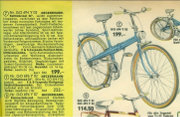 touring model was DM94.50.
touring model was DM94.50.
Neckermann initially offered the folder in a chic metallic blue or, for an additional DM9.50, metallic red or green. The pump clipped to the frame and the tools lived in a saddle bag. The following three or four years brought various running changes, such as the tool kit and pump moving inside the frame, and the adoption of a 'three arrows’ crankset (in this case rust-enhanced).
At some stage an unusual kind of plating – resembling alloy (maybe it is?) – supplanted the chrome on the rims. A shame, as this dull, nondescript finish cannot compare to chrome, and I think it lowers the tone of the whole bike. Non-metallic 'sea blue' became the only colour available, but gold pinstriping remained a valued part of the package.
The cross frame
The Neckermann folder is of course notable for its distinctive 'cross' frame, which is made of steel pressings instead of the cast alloy of the Hermann Klaue referred to above. Both were far from being the first to use the cross frame design, but maybe the Neckermann could claim to be the first to fold.
The Neckermann frame comprises two sections joined by a heavy cast hinge. Each section is made of a pair of thick pressings clam-shelled together vertically. The forward section incorporates what  would normally be the steer tube. The distended rear section is intersected at 90° by the seat tube (which extends some distance below to support the bottom bracket), beyond which it bifurcates to form the chain stays.
would normally be the steer tube. The distended rear section is intersected at 90° by the seat tube (which extends some distance below to support the bottom bracket), beyond which it bifurcates to form the chain stays.
Speaking of the bottom bracket, this example is a little unusual, being of the 'Thompson' type (a first for Bootiebike). It is rather like a scaled-up version of the familiar cup and cone arrangement used for wheel bearings. The bearing cups, fixed in the bottom bracket shell, face outwards. The cones are on the (threaded) spindle; one is fixed, the other screws inwards to adjust the play.
The world's slowest gearchange
The Neckermann folder featured here is fitted with the optional Fichtel and Sachs Torpedo model 515 rear hub, a three speed unit with coaster brake. The gears are a pleasure to use if – and it's a big if – one can master the gear change trigger control. This is an issue because the trigger is fitted under the seat instead of on the handlebars. 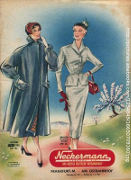 It seems the designers were concerned about the control cable getting in the way during folding/unfolding of the bike.
It seems the designers were concerned about the control cable getting in the way during folding/unfolding of the bike.
While the gearchange is awkward at the best of times, it's not so much of a problem when speeding up, as you can take your time when changing up, and the trigger ‘flicks’ to a higher gear. However, care is required when changing down, and much precious momentum can be lost while fumbling around the rear of the, er, bike. The three speed option was replaced by the trigger-less Duomatic two-speed in the (northern) autumn catalogue of 1965-66. I’m surprised it took so long.
At least folding the bike is straightforward, or I think so anyway; simply undo a wing nut on the hinge. With that done the handlebars can be tucked out of the way, and to this end the handlebar stem is split into two. A screw release allows the upper part of the stem, with bars, to be lifted off the lower part and swung over to one side. A small screw through a slotted tab on each piece keeps the upper part from going astray. Unfortunately, this arrangement precludes any height adjustment for the handlebars. I may think folding the Neckermann is easy enough, but the Authentic Vintage Bicycles website begs to differ, describing it as an ordeal to say the least, usually involving damage to fingers, bike, or both!
The bits and pieces
The curvaceous Neckermann frame abounds with interesting little details, such as the curved tab securing the forward end of the rear guard. I love how they made a feature of the central seam with that dinky bright trim. 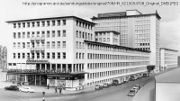 Very neat is the integrated headlight. Being affixed to the steer tube, it doesn’t turn with the handlebars, which for some reason can be a bit disorienting to the rider. Those who ride a Moulton with a front rack (which, being frame mounted, doesn't turn with the steering) will know the feeling.
Very neat is the integrated headlight. Being affixed to the steer tube, it doesn’t turn with the handlebars, which for some reason can be a bit disorienting to the rider. Those who ride a Moulton with a front rack (which, being frame mounted, doesn't turn with the steering) will know the feeling.
The Neckermann has a rear rack that is similar to that of the original Hermann Klaue bikes – straightforward yet nicely detailed, even attractive. No complaints, but it can't bear comparison with the bauhaus-inspired version on the Hercules 2000, with its uprights gracefully arcing rearwards from the dropouts. Only the Germans could make a bike luggage rack sexy. The rack on the Neckermann was originally equipped with a built-in rubber strap to hold one's 'luggage'. I hope to replace this when I can find some suitable rubber.
Those of us familiar with only Sturmey Archer hubs will be intrigued by the little sleeve with a stepped tab clinging to the indicator nut. It's there to aid gear adjustment (I think the gears are adjusted correctly when, while in top gear, the locknut is adjacent to the last 'step'). Another little feature to make life easier is the securing of the coaster brake arm in the channel formed by the left chainstay. The end of the arm just slots in – there's no screw and nut to worry about. 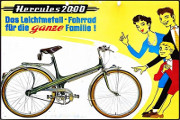 The only problem is the tendency for the arm to move within the channel (producing a 'clunk') when changing gears or applying the coaster brake – a problem cured by a little rubber insulation.
The only problem is the tendency for the arm to move within the channel (producing a 'clunk') when changing gears or applying the coaster brake – a problem cured by a little rubber insulation.
The comfy saddle comes courtesy of Mertens, and the bell is by the old-established and still-extant German bicycle accessory firm 'Trelock'. The pedals have coloured-glass (yes, glass) reflectors. The bike came equipped with a friction dynamo lighting set.
This example
This example is in very original condition, despite a lengthy rust-gathering hiatus. Unfortunately, I couldn't avoid replacing a few parts that were too rusty, such as the handlebars and seat post. There's some paint loss and scratching to the frame, mostly on the rack, but overall it looks ok from a metre or two away. The bike retains its original 'Hengstler' chain, partially concealed by an alloy chainguard. The latter lends a touch of class, despite a few battle scars.
The original French Wolber semi-balloon gumwalls survive, albeit with much superficial sidewall cracking. They look great and give a nice comfy ride. However, they live on wheels of doubtful quality, which is surprising for such a costly bike. For a start, the rims seem very flimsy, certainly nothing like the rims on the English bikes of that era. (On the other hand,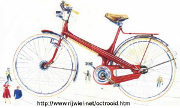 maybe they have all the strength that's needed with those soft, fat tyres absorbing the worst of the bumps.) And the aforementioned non-chrome plating does them no favours in the appearance department. The labels concealing the manufacturing join have begun to vanish, revealing an untidy band of unfinished metal.
maybe they have all the strength that's needed with those soft, fat tyres absorbing the worst of the bumps.) And the aforementioned non-chrome plating does them no favours in the appearance department. The labels concealing the manufacturing join have begun to vanish, revealing an untidy band of unfinished metal.
The original spoke nipples were of plated steel rather than brass, and were thus terminally rusty; The spokes rusted too, but somehow they were salvageable. The mudguards have the same 'alloy’ plating as the rims, but this is compensated by the application of gold and blue striping. This must have looked stunning when the bike was new, which is something I doubt anyone ever said about the crude metal strap struggling to support the rear guard.
I hope you've enjoyed reading about the Neckermann folder. Cruisy, comfy and upright, ponderous but pleasant, it does all you expect as long as you're not in a hurry. I'm even threatening to get used to the gear change. Overall, a very beautiful, appealing bike. It has its faults, but I'll take it because I'm a sucker for looks. Just ask my partner…


